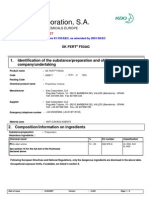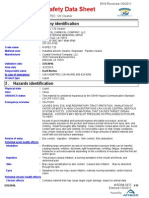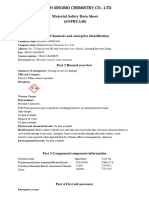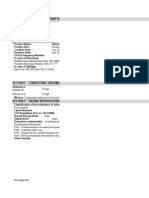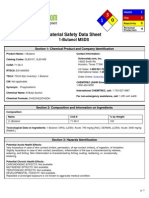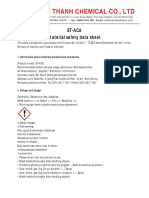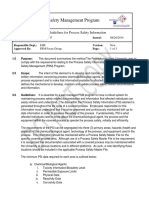Safety Data Sheet: Section 1. Identification
Safety Data Sheet: Section 1. Identification
Uploaded by
Behnam NoorizadehCopyright:
Available Formats
Safety Data Sheet: Section 1. Identification
Safety Data Sheet: Section 1. Identification
Uploaded by
Behnam NoorizadehOriginal Title
Copyright
Available Formats
Share this document
Did you find this document useful?
Is this content inappropriate?
Copyright:
Available Formats
Safety Data Sheet: Section 1. Identification
Safety Data Sheet: Section 1. Identification
Uploaded by
Behnam NoorizadehCopyright:
Available Formats
SAFETY DATA SHEET
Section 1. Identification
Product identifier
: LEWATIT S 1567
Material Number
: 56695609
Identified uses
: Ion Exchange Resin
: LANXESS Corporation
Sybron Chemicals,Inc
200 Birmingham Road
Birmingham, NJ 08011
USA
Supplier/Manufacturer
In case of emergency
For information: US/Canada (800) LANXESS
: Chemtrec (800) 424-9300
International (703) 527-3887
Lanxess Emergency Phone (800) 410-3063.
International +1 412 809 1000
Section 2. Hazards identification
HAZCOM Standard Status
Physical state
: While this material is not considered hazardous by the OSHA Hazard Communication
Standard (29 CFR 1910.1200), this MSDS contains valuable information critical to the
safe handling and proper use of the product. This MSDS should be retained and
available for employees and other users of this product.
: Solid.
Color
: Brown. [Dark]
Classification of the
substance or mixture
Signal word
: Not classified.
Hazard statements
Hazard Not Otherwise
Classified (HNOC)
Precautionary statements
: No known significant effects or critical hazards.
: None known.
Prevention
Response
Storage
: Not applicable.
: Not applicable.
: Not applicable.
Disposal
: Not applicable.
Supplemental label
elements
: Store in original container protected from direct sunlight in a dry, cool and well-ventilated
area, away from incompatible materials and food and drink.
: No signal word.
Section 3. Composition/information on ingredients
Substance/mixture
: Mixture
There are no ingredients present which, within the current knowledge of the supplier and in the concentrations
applicable, are classified as hazardous to health and hence require reporting in this section.
Occupational exposure limits, if available, are listed in Section 8.
LEWATIT S 1567
56695609
Version
1/7
Section 4. First aid measures
Description of first aid measures
Eye contact
: No known significant effects or critical hazards.
Inhalation
: Remove victim to fresh air and keep at rest in a position comfortable for breathing. Get
medical attention if symptoms occur.
: Flush contaminated skin with plenty of water. Remove contaminated clothing and shoes.
Get medical attention if symptoms occur.
: Wash out mouth with water. Remove victim to fresh air and keep at rest in a position
comfortable for breathing. If material has been swallowed and the exposed person is
conscious, give small quantities of water to drink. Do not induce vomiting unless
directed to do so by medical personnel. Get medical attention if symptoms occur.
Skin contact
Ingestion
Potential acute health effects
Eye contact
: No known significant effects or critical hazards.
Inhalation
: No known significant effects or critical hazards.
Skin contact
: No known significant effects or critical hazards.
Ingestion
: No known significant effects or critical hazards.
Over-exposure signs/symptoms
Eye contact
: No specific data.
Inhalation
: No specific data.
Skin contact
: No specific data.
Ingestion
: No specific data.
Potential chronic health effects
No known significant effects or critical hazards.
Notes to physician
Protection of first-aiders
: Treat symptomatically. No specific treatment.
: No special measures required.
See toxicological information (Section 11)
Section 5. Fire-fighting measures
Extinguishing media
Suitable extinguishing
media
: Use an extinguishing agent suitable for the surrounding fire. In case of fire, use water
spray (fog), foam or dry chemical.
Unsuitable extinguishing
media
: None known.
Specific hazards arising
from the chemical
: No specific fire or explosion hazard.
Hazardous thermal
decomposition products
: Decomposition products may include the following materials:
carbon dioxide
carbon monoxide
metal oxide/oxides
Special protective actions
for fire-fighters
: Promptly isolate the scene by removing all persons from the vicinity of the incident if
there is a fire. No action shall be taken involving any personal risk or without suitable
training.
: Fire-fighters should wear appropriate protective equipment and self-contained breathing
apparatus (SCBA) with a full face-piece operated in positive pressure mode.
Special protective
equipment for fire-fighters
LEWATIT S 1567
56695609
Version
2/7
Section 6. Accidental release measures
Personal precautions,
protective equipment and
emergency procedures
: No action shall be taken involving any personal risk or without suitable training.
Evacuate surrounding areas. Keep unnecessary and unprotected personnel from
entering. Do not touch or walk through spilled material. Put on appropriate personal
protective equipment. Hazard of slipping on spilled product.
Environmental precautions
: Avoid dispersal of spilled material and runoff and contact with soil, waterways, drains
and sewers. Inform the relevant authorities if the product has caused environmental
pollution (sewers, waterways, soil or air).
Methods and materials for
: Move containers from spill area. Vacuum or sweep up material and place in a
designated, labeled waste container. Dispose of via a licensed waste disposal
containment and cleaning up
contractor. Note: see Section 1 for emergency contact information and Section 13 for
waste disposal. Prevent entry into sewers, water courses, basements or confined areas.
Section 7. Handling and storage
Precautions for safe handling
Protective measures
: Remove contaminated clothing and protective equipment before entering eating areas.
Workers should wash hands and face before eating, drinking and smoking. Put on
appropriate personal protection equipment. Eating, drinking and smoking should be
prohibited in areas where this material is handled, stored and processed.
Conditions for safe storage : Store between the following temperatures: -20 to 40C (-4 to 104F). Store in
accordance with local regulations. Store in original container protected from direct
sunlight in a dry, cool and well-ventilated area, away from incompatible materials (see
Section 10) and food and drink. Keep container tightly closed and sealed until ready for
use. Containers that have been opened must be carefully resealed and kept upright to
prevent leakage. Do not store in unlabeled containers. Use appropriate containment to
avoid environmental contamination. Empty containers or liners may retain some product
residues. It is recommended to store ion exchange resins at temperatures above the
freezing point of water. If the resin should become frozen, the resin should not be
mechanically handled and should be left to thaw out gradually at ambient temperature.
It must be completely thawed before handling or use. No attempt should be made to
accelarate the thawing process.
Section 8. Exposure controls/personal protection
Occupational exposure limits
No exposure limit value known.
Appropriate engineering
controls
: Good general ventilation should be sufficient to control worker exposure to airborne
contaminants.
Personal protection
Hygiene measures
Respiratory protection
Skin protection
Eye/face protection
Medical Surveillance
LEWATIT S 1567
: Wash hands, forearms and face thoroughly after handling chemical products, before
eating, smoking and using the lavatory and at the end of the working period. Appropriate
techniques should be used to remove potentially contaminated clothing. Wash
contaminated clothing before reusing. Ensure that eyewash stations and safety showers
are close to the workstation location.
: Respirator selection must be based on known or anticipated exposure levels, the
hazards of the product and the safe working limits of the selected respirator.
: Wear suitable protective clothing and gloves. Suitable protective footwear.
: If contact with product is possible, wear safety glasses with side shields.
: Not available.
56695609
Version
3/7
Section 9. Physical and chemical properties
Physical state
: Solid. [beads]
Color
: Brown. [Dark]
Odor
Odor threshold
: Characteristic. [Slight]
: Not available.
pH
Boiling point
Melting point
Flash point
:
:
:
:
8 [Conc. (% w/w): 10%]
Not available.
Not available.
Not available.
Evaporation rate
Explosion limits
Vapor pressure
Density
Specific gravity (Relative
density)
Bulk density
Solubility
Partition coefficient: noctanol/water
Vapor density
Viscosity
:
:
:
:
:
Not available.
Not available.
Not available.
1,28 g/cm
1,3
Combustibility at 20 C
Ignition temperature
Auto-ignition temperature
Decomposition temperature
:
:
:
:
: 805 kg/m
: Insoluble in the following materials: cold water
: Not available.
: Not available.
: Not available.
BZ 1 = no ignition (VDI 2263).
>250C
Not available.
Not available.
Section 10. Stability and reactivity
Reactivity
Chemical stability
Possibility of hazardous
reactions
Conditions to avoid
Incompatible materials
Hazardous decomposition
products
: No specific test data related to reactivity available for this product or its ingredients.
: The product is stable.
: Under normal conditions of storage and use, hazardous reactions will not occur.
: No specific data.
: Strong oxidants, e.g. nitric acid, can cause violent reactions if they come into contact
with ion exchange resins.
: Under normal conditions of storage and use, hazardous decomposition products should
not be produced.
Section 11. Toxicological information
Information on the likely
routes of exposure
: Dermal contact. Eye contact.
Potential acute health effects
Eye contact
: No known significant effects or critical hazards.
Inhalation
: No known significant effects or critical hazards.
Skin contact
: No known significant effects or critical hazards.
Ingestion
: No known significant effects or critical hazards.
Symptoms related to the physical, chemical and toxicological characteristics
Eye contact
: No specific data.
Inhalation
: No specific data.
Skin contact
: No specific data.
Ingestion
LEWATIT S 1567
: No specific data.
56695609
Version
4/7
Section 11. Toxicological information
Potential chronic health effects
Short term exposure
Potential immediate
: Not available.
effects
Long term exposure
Potential delayed effects
General
Carcinogenicity
: Not available.
: No known significant effects or critical hazards.
: No known significant effects or critical hazards.
Mutagenicity
: No known significant effects or critical hazards.
Teratogenicity
: No known significant effects or critical hazards.
Developmental effects
: No known significant effects or critical hazards.
Fertility effects
: No known significant effects or critical hazards.
Information on toxicological effects
Acute toxicity
Product/ingredient name
LEWATIT S 1567
Result
LD50 Oral
Species
Rat
Dose
Exposure
>5000 mg/kg
Test
-
Irritation/Corrosion
Conclusion/Summary
Skin
Eyes
: Non-irritating *Test results on an analogous product
: Non-irritating *Test results on an analogous product
Acute toxicity estimates
Route
ATE value (Acute Toxicity Estimates)
Not available.
Section 12. Ecological information
Toxicity
Not available.
Conclusion/Summary
: Not available.
Persistence and degradability
Conclusion/Summary
Bioaccumulative potential
Not available.
: Not available.
Mobility in soil
Soil/water partition
coefficient (KOC)
Other adverse effects
: Not available.
: No known significant effects or critical hazards.
Section 13. Disposal considerations
Disposal methods
LEWATIT S 1567
: The generation of waste should be avoided or minimized wherever possible. Dispose of
surplus and non-recyclable products via a licensed waste disposal contractor. This
material and its container must be disposed of in a safe way. Empty containers or liners
may retain some product residues. Avoid dispersal of spilled material and runoff and
contact with soil, waterways, drains and sewers. Waste disposal should be in
accordance with existing federal state, provincial and or local environmental controls
laws.
56695609
Version
5/7
Section 13. Disposal considerations
RCRA classification
: If discarded in its purchased form, this product would not be a hazardous waste either
by listing or by characteristic. However, under RCRA, it is the responsibility of the
product user to determine at the time of disposal, whether a material containing the
product or derived from the product should be classified as a hazardous waste. (40
CFR 261.20-24)
Section 14. Transport information
Regulatory
information
UN number
Proper shipping
name
Classes
PG* Label
Additional
information
DOT Classification
Not regulated.
IMDG Class
Not regulated.
IATA-DGR Class
Not regulated.
PG* : Packing group
RQ
: 0 lbs
Section 15. Regulatory information
SARA 311/312
: Not applicable.
SARA Title III Section 302
Extremely Hazardous
Substances
: None
SARA Title III Section 313
Toxic Chemicals
: None
US EPA CERCLA
: None
Hazardous Subtances (40
CFR 302)
State regulations
The following chemicals are specifically listed by individual states; other product specific health and safety data in other
sections on the SDS may also be applicable for state requirements. For details on your regulatory requirements you
should contact the appropraite agency in your state.
Ingredient name
CAS number
State Code
Concentration
(%)
Benzene, diethenyl-, polymer with
69011-22-9
54 - 60%
ethenylbenzene, sulfonated,
sodiumsalts
Water
7732-18-5
40 - 46%
Massachusetts Substances: MA - S
Massachusetts Extraordinary Hazardous Substances: MA - Extra HS
New Jersey Hazardous Substances: NJ - HS
Pennsylvania RTK Hazardous Substances: PA - RTK HS
Pennsylvania Special Hazardous Substances: PA - Special HS
California Prop. 65
To the best of our knowledge, this product does not contain any of the listed chemicals, which the state of California has
found to cause cancer, birth defects or other reproductive harm.
U.S. Toxic Substances
Control Act
LEWATIT S 1567
: Listed on the TSCA Inventory.
56695609
Version
6/7
Section 16. Other information
Hazardous Material
Information System
Health
Flammability
Physical hazards
0=Insignificant 1=Slight 2=Moderate 3=High 4=Extreme
*=Chronic
The customer is responsible for determining the PPE code for this material. HMIS ratings are to be used with a
fully implemented HMIS program. HMIS is a registered mark of the National Paint & Coatings Association
(NPCA). HMIS materials may be purchased exclusively from J. J. Keller (800) 327-6868.
No
National Fire Protection
:
Association (U.S.A.)
Flammability
1
Health
Instability/Reactivity
Special
0= Minimal 1=Slight 2=Moderate 3=Serious 4=Severe
LANXESS' method of hazard communication is comprised of Product Labels and Safety Data Sheets. HMIS and
NFPA ratings are provided by LANXESS as a customer service.
Reprinted with permission from NFPA 704-2001, Identification of the Hazards of Materials for Emergency
Response Copyright 1997, National Fire Protection Association, Quincy, MA 02269. This reprinted material is not
the complete and official position of the National Fire Protection Association, on the referenced subject which is
represented only by the standard in its entirety.
No
Date of issue
Date of previous issue
Version
: 06-05-2013
: No previous validation
: 1
Product Safety and Regulatory Affairs
Indicates information that has changed from previously issued version.
No
Notice to reader
This information is furnished without warranty, express or implied. This information is believed to be accurate to
the best knowledge of LANXESS Corporation. The information in this MSDS relates only to the specific material
designated herein. LANXESS Corporation assumes no legal responsibility for use of or reliance upon the
information in this MSDS.
You might also like
- The Health & Safety Guide for Film, TV & Theater, Second EditionFrom EverandThe Health & Safety Guide for Film, TV & Theater, Second EditionRating: 4 out of 5 stars4/5 (1)
- Sikabond NV MsdsDocument5 pagesSikabond NV Msdsudadaripaddang100% (1)
- SK Fert F50ag-MsdsDocument6 pagesSK Fert F50ag-MsdsEmadNo ratings yet
- N Spec 120 Cleaner Data SheetDocument11 pagesN Spec 120 Cleaner Data SheetSergio Alejandro Loza EscobarNo ratings yet
- Sinobio MSDS Snpbta40Document5 pagesSinobio MSDS Snpbta40unaliu622No ratings yet
- XL 740htDocument6 pagesXL 740htramsi17No ratings yet
- Ulvac R-7 SDSDocument5 pagesUlvac R-7 SDSMauricio OchoaNo ratings yet
- SikaCem Concentrate - MSDSDocument5 pagesSikaCem Concentrate - MSDSLou Melvin CruzNo ratings yet
- RustGo MSDSDocument6 pagesRustGo MSDSFitrianis NovitaNo ratings yet
- SikaRail KC 340 - 45Document12 pagesSikaRail KC 340 - 45MikeNo ratings yet
- Propylene Glycol USP MSDSDocument6 pagesPropylene Glycol USP MSDSeprastyo_3No ratings yet
- Msds Sika ViscoCrete 1000Document5 pagesMsds Sika ViscoCrete 1000Gabo TellezNo ratings yet
- 2,3,5 Triphenyl 2H Tetrazolium ChlorideDocument4 pages2,3,5 Triphenyl 2H Tetrazolium Chloridecowpea2009No ratings yet
- MSDS Cat 108-8611 GrasaDocument12 pagesMSDS Cat 108-8611 Grasanauta007No ratings yet
- Actellic 50 EcDocument9 pagesActellic 50 Ecnadi1onlyNo ratings yet
- Acetophenon PDFDocument6 pagesAcetophenon PDFYuris Yurdiansah Munandar0% (1)
- Acetophenone PDFDocument6 pagesAcetophenone PDFYuliana Ja'farNo ratings yet
- Qwe 345Document20 pagesQwe 345Aditya UnniNo ratings yet
- Carbodur MSDSDocument5 pagesCarbodur MSDSAbrahim KazzazNo ratings yet
- Zinc Oxide (Umicore)Document6 pagesZinc Oxide (Umicore)Ita SupriatinNo ratings yet
- Maleic Anhydride MSDS: Section 1: Chemical Product and Company IdentificationDocument6 pagesMaleic Anhydride MSDS: Section 1: Chemical Product and Company IdentificationFábio BrancoNo ratings yet
- Mono Ethylene Glycol MEGDocument6 pagesMono Ethylene Glycol MEGtabriz.alizada.engNo ratings yet
- MSDS SPN 80 - PT Tritunggal ArthamakmurDocument8 pagesMSDS SPN 80 - PT Tritunggal ArthamakmurSeftia NurfaNo ratings yet
- Msds Diaseton AlkoholDocument5 pagesMsds Diaseton AlkoholtakenoveraccountNo ratings yet
- Pep Set Al5995 CatalystDocument11 pagesPep Set Al5995 CatalystfeelingzudoNo ratings yet
- Safety Data Sheet: Identification of The Substance/Preparation and of The Company/Undertaking 1Document7 pagesSafety Data Sheet: Identification of The Substance/Preparation and of The Company/Undertaking 1Bao Duy NguyenNo ratings yet
- SDS PVAc 3333 EN 220510Document9 pagesSDS PVAc 3333 EN 220510juprykaNo ratings yet
- Material Safety Data Sheet: Product and Company Identification 1Document9 pagesMaterial Safety Data Sheet: Product and Company Identification 1Geovonni Almosthadme OsbourneNo ratings yet
- Ghs Calcium Glycerophosphate MsdsDocument6 pagesGhs Calcium Glycerophosphate MsdsSRI VYJAYANTHI QANo ratings yet
- Butil AlkoholDocument6 pagesButil Alkoholmicaziv4786No ratings yet
- Thiamine HCL MSDS: Section 1: Chemical Product and Company IdentificationDocument5 pagesThiamine HCL MSDS: Section 1: Chemical Product and Company IdentificationAurora Buitrago RuízNo ratings yet
- Kodak Fixer Working SolutionDocument11 pagesKodak Fixer Working Solutiongreaternorthroad8820No ratings yet
- MsdsDocument5 pagesMsdsRizqi S RohmandaniNo ratings yet
- Msds of GlycidolDocument6 pagesMsds of GlycidolDinesh TanwarNo ratings yet
- SDS - Jotamastic 87 - Comp. A - Marine - Protective - English (Us) - United StatesDocument8 pagesSDS - Jotamastic 87 - Comp. A - Marine - Protective - English (Us) - United Stateskhor_albertNo ratings yet
- MSDS - Isoamil AlkoholDocument6 pagesMSDS - Isoamil AlkoholAyu MurtiNo ratings yet
- Flexclean SDS 2018Document10 pagesFlexclean SDS 2018inferno_bsNo ratings yet
- Ion Exchange Resin Lewatit CNP 80 Material Safety Data SheetDocument6 pagesIon Exchange Resin Lewatit CNP 80 Material Safety Data SheetherdianpebiNo ratings yet
- Material Safety Data SheetDocument6 pagesMaterial Safety Data SheetAyie Rawk100% (2)
- SDS - Jotun Thinner No. 07 - Marine - Protective - English (Uk) - SingaporeDocument5 pagesSDS - Jotun Thinner No. 07 - Marine - Protective - English (Uk) - SingaporeAmi Terecef Gamboa MirandaNo ratings yet
- Msds Butyl AcetateDocument6 pagesMsds Butyl AcetateArsalan Ahmad KhanNo ratings yet
- Diethylene GlycolDocument5 pagesDiethylene Glycolsatnam1979No ratings yet
- SDS - Pilot II - Marine - Protective - English (Uk) - SingaporeDocument5 pagesSDS - Pilot II - Marine - Protective - English (Uk) - SingaporeAmi Terecef Gamboa MirandaNo ratings yet
- Safety Data Sheet: Section 1. IdentificationDocument10 pagesSafety Data Sheet: Section 1. IdentificationFaizan NazirNo ratings yet
- Lockstop Primer Adhesive SDS-GreenstreakDocument11 pagesLockstop Primer Adhesive SDS-Greenstreakrobox514No ratings yet
- EthylacetateDocument5 pagesEthylacetateA.Magied MahmoudNo ratings yet
- Msds Acetyl ChlorideDocument6 pagesMsds Acetyl ChlorideghungrudswapnilNo ratings yet
- Uranium Nitrate MsdsDocument8 pagesUranium Nitrate MsdsAnonymous mZEUquNo ratings yet
- Section 5: Fire and Explosion DataDocument5 pagesSection 5: Fire and Explosion DataSayed SalahNo ratings yet
- Msds BaCl2Document6 pagesMsds BaCl2Iman Haerudin0% (1)
- Katalco 32-4Document11 pagesKatalco 32-4lilita151No ratings yet
- Enprep - 110 EC Steel Cu Brass MSDSDocument5 pagesEnprep - 110 EC Steel Cu Brass MSDSLựuLiềuLìNo ratings yet
- KCLO3Document6 pagesKCLO3Raditya Rizki AmaliaNo ratings yet
- Msds St-Aca English 2023Document7 pagesMsds St-Aca English 2023danghoangtube002No ratings yet
- Công Ty Tnhh Organo (Vi T Nam) Ệ Phiuantoànhóacht Ế ẤDocument6 pagesCông Ty Tnhh Organo (Vi T Nam) Ệ Phiuantoànhóacht Ế ẤBao Duy NguyenNo ratings yet
- Survival Skills: How to Survive Anything and Anywhere in the World (A Comprehensive Guide to Preparing for and Overcoming Challenges of Earthquakes)From EverandSurvival Skills: How to Survive Anything and Anywhere in the World (A Comprehensive Guide to Preparing for and Overcoming Challenges of Earthquakes)No ratings yet
- After a Disaster - Information to Help You and Your Family RecoverFrom EverandAfter a Disaster - Information to Help You and Your Family RecoverNo ratings yet
- Material Safety Data Sheet: in Compliance With ABNT NBR 14725-4:2014Document4 pagesMaterial Safety Data Sheet: in Compliance With ABNT NBR 14725-4:2014Leonardo SoaresNo ratings yet
- Kerosene PDFDocument9 pagesKerosene PDFishnafathonahNo ratings yet
- PEG-40 Hydrogenated Castor Oil MsdsDocument2 pagesPEG-40 Hydrogenated Castor Oil Msdsjangri1098No ratings yet
- 5 Chloro 2 Methyl 4 Isothiazolin 3 OneDocument6 pages5 Chloro 2 Methyl 4 Isothiazolin 3 OnefefeauliaNo ratings yet
- HTW 2 3 1 Model Course Advanced Training For Chemical Tanker Cargo Operations SecretariatDocument297 pagesHTW 2 3 1 Model Course Advanced Training For Chemical Tanker Cargo Operations SecretariatEnnio Palumbo67% (6)
- PCI Lastogum v3Document2 pagesPCI Lastogum v3Jaga NathNo ratings yet
- Rescocast 17 MSDSDocument3 pagesRescocast 17 MSDSgroovercm15No ratings yet
- Updated SDS Volvo Group Februari 2023Document4 pagesUpdated SDS Volvo Group Februari 2023Olivier DupNo ratings yet
- 02 - Process Safety Information WebDocument10 pages02 - Process Safety Information WebTaufik ZainuddinNo ratings yet
- Safety Data Sheet CPP H12 Sink and Drain Unblocker: Revision Date: 18/05/2022Document12 pagesSafety Data Sheet CPP H12 Sink and Drain Unblocker: Revision Date: 18/05/2022centeaNo ratings yet
- Biocide MSDSDocument5 pagesBiocide MSDSBalu VedhachalamNo ratings yet
- 840 45101 01 Acrysol Ase60 Er Rheology Modifier TdsDocument3 pages840 45101 01 Acrysol Ase60 Er Rheology Modifier TdsFadilla Azhari100% (1)
- PR 1750 Class BDocument2 pagesPR 1750 Class BshadiNo ratings yet
- Ceramic Polymer STP Ep HV Part A - V 1,04 - 2016!02!19 - GB en CP 90 ADocument10 pagesCeramic Polymer STP Ep HV Part A - V 1,04 - 2016!02!19 - GB en CP 90 AhainguyenbkvhvNo ratings yet
- Msds BoraxDocument5 pagesMsds BoraxmeitakurniatiNo ratings yet
- ALDEHYDE C-16 FCC Safety Data Sheet: 1. IdentificationDocument9 pagesALDEHYDE C-16 FCC Safety Data Sheet: 1. IdentificationAli AhmedNo ratings yet
- Msds OctaneDocument5 pagesMsds Octanenirmal_subudhiNo ratings yet
- Standard Operating Procedure (SOP) : CentrifugationDocument12 pagesStandard Operating Procedure (SOP) : CentrifugationBassam AlharaziNo ratings yet
- Understanding Safety Data Sheets Fact SheetDocument9 pagesUnderstanding Safety Data Sheets Fact SheetMuthukumar SankaranNo ratings yet
- VX193 - MSDSDocument14 pagesVX193 - MSDSMohamed HalemNo ratings yet
- SDS Kapci 201 GBDocument8 pagesSDS Kapci 201 GBchicoetenacNo ratings yet
- 971-0022-A000 - MSDS RDocument5 pages971-0022-A000 - MSDS Rjalw88No ratings yet
- HF150 Oil Safety Data Sheet For HF100 HF101 HF102 and HF104 Oils en-USDocument10 pagesHF150 Oil Safety Data Sheet For HF100 HF101 HF102 and HF104 Oils en-USEng.arifNo ratings yet
- Gorgon Emp Offshore Feed Gas Pipeline Installation Management PlanDocument364 pagesGorgon Emp Offshore Feed Gas Pipeline Installation Management Planafasf100% (1)
- Bayferrox 222 FMDocument4 pagesBayferrox 222 FMsdsdvsdvsdNo ratings yet
- KHS Pressure Fluid 15 Hoja de SeguridadDocument13 pagesKHS Pressure Fluid 15 Hoja de SeguridadpbshriveraNo ratings yet
- TrilonDocument9 pagesTrilonFitra Isni RositaNo ratings yet
- SMR-A56B Conductive CementDocument5 pagesSMR-A56B Conductive CementJorge AlvarezNo ratings yet
- General Letter CAS-InquiriesDocument1 pageGeneral Letter CAS-InquiriesTrinhTruongNo ratings yet



